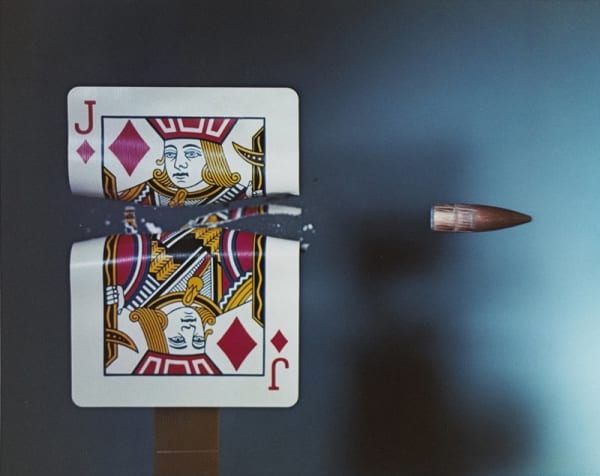Harold Edgerton American, 1903-1990
Works
-
 Football Placement Kick, 1934.
Football Placement Kick, 1934. -
 Golf drive by Densmore Shute, 1938.
Golf drive by Densmore Shute, 1938. -
 Swirls and eddies of a tennis stroke, 1939.
Swirls and eddies of a tennis stroke, 1939. -
 Action at the Rodeo, 1940
Action at the Rodeo, 1940 -
 A Girl and her Horse, 1941.
A Girl and her Horse, 1941. -
 Tennis Serve, 1952.
Tennis Serve, 1952. -
 Milk Drop Coronet, 1957.
Milk Drop Coronet, 1957. -
 Cutting the Playing Card Quickly, 1964.
Cutting the Playing Card Quickly, 1964. -
 30 Caliber Bullet Piercing an Apple, 1964.
30 Caliber Bullet Piercing an Apple, 1964. -
 Pole vaulter, David Tork , 1964.
Pole vaulter, David Tork , 1964. -
 Shock Waves from Impact, 1965.
Shock Waves from Impact, 1965. -
 Vortex at a fan blade tip with Kim Vandiver, 1973.
Vortex at a fan blade tip with Kim Vandiver, 1973.
Exhibitions
On Tour
Press
-

Inheriting Dreams: the living legacy of photography
Gaspar Keri, Punkt, 13 October 2025 -

Inheriting Dreams
Christian Caujolle, The Eye of Photography, 30 September 2025 -

Yesterday's photographs are today's world
Ianko López, El País Semanal, 14 September 2025 -

Max Saula: Heir to a vision
Rafael Lozano, La Vanguardia, 7 September 2025
Newsletter
Biography
Harold "Doc" Edgerton, born on April 6, 1903, and died on January 4, 1990, was an American scientist, electrical engineer, and inventor.
He was a professor at the Massachusetts Institute of Technology (MIT) and is best known for his invention of the strobe light, which revolutionized photography, science, military surveillance, and filmmaking.
Edgerton's work was the subject of a retrospective at the International Center of Photography, and he was given ICP's Infinity Award for Lifetime Achievement in 1987.
He also performed the first-ever underwater time-lapse photography in 1968 and invented various sonar devices. Edgerton's innovative work has had a lasting impact on various fields, and he is celebrated for his philosophy of "Work hard. Tell everyone everything you know. Close a deal with a handshake. Have fun!"
His photographs were exhibited for the first time in 1933, at the Royal Photographic Society in London, and Beaumont Newhall included his work in the first exhibition of photography at the Museum of Modern Art in 1937.
The photographs that resulted from his scientific experiments were championed in the 1930s as representative of the New Objectivity, the American counterpart to the German Neue Sachlichkeit.
Edgerton's photography of split-second motion may be seen as an expansion beyond the nineteenth-century locomotion studies of by Eadweard Muybridge and Étienne-Jules Marey.



















